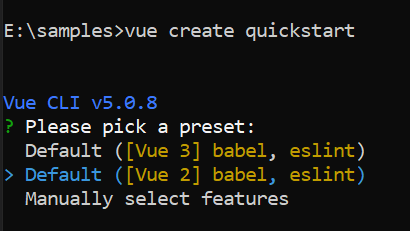Getting Started with the Vue Circular Gauge Component in Vue 2
25 Apr 20255 minutes to read
This article provides a step-by-step guide for setting up a Vue 2 project using Vue-CLI and integrating the Syncfusion® Vue Circular Gauge component.
Prerequisites
System requirements for Syncfusion® Vue UI components
Dependencies
Below is the list of minimum dependencies required to use the Circular Gauge.
|-- @syncfusion/ej2-vue-circulargauge
|-- @syncfusion/ej2-base
|-- @syncfusion/ej2-buttons
|-- @syncfusion/ej2-popups
|-- @syncfusion/ej2-splitbuttons
|-- @syncfusion/ej2-vue-base
|-- @syncfusion/ej2-svg-base
|-- @syncfusion/ej2-circulargaugeSetting up the Vue 2 project
To generate a Vue 2 project using Vue-CLI, use the vue create command. Follow these steps to install Vue CLI and create a new project:
npm install -g @vue/cli
vue create quickstart
cd quickstart
npm run serveor
yarn global add @vue/cli
vue create quickstart
cd quickstart
yarn run serveWhen creating a new project, choose the option Default ([Vue 2] babel, eslint) from the menu.

Once the quickstart project is set up with default settings, proceed to add Syncfusion® components to the project.
Add Syncfusion® Vue packages
Syncfusion® packages are available at npmjs.com. To use Vue components, install the required npm package.
This article uses the Vue Circular gauge component as an example. Install the @syncfusion/ej2-vue-circulargauge package by running the following command:
npm install @syncfusion/ej2-vue-circulargauge --saveor
yarn add @syncfusion/ej2-vue-circulargaugeAdding Syncfusion® Vue Circular Gauge component
Follow the below steps to add the Vue Circular Gauge component:
1. First, import and register the Circular Gauge component in the script section of the src/App.vue file.
<script>
import { CircularGaugeComponent } from '@syncfusion/ej2-vue-circulargauge';
export default {
components: {
'ejs-circulargauge': CircularGaugeComponent
}
}
</script>2. In the template section, define the Circular Gauge component.
<template>
<div id="app">
<div class='wrapper'>
<ejs-circulargauge ></ejs-circulargauge>
</div>
</div>
</template>Here is the summarized code for the above steps in the src/App.vue file:
<template>
<div id="app">
<div class='wrapper'>
<ejs-circulargauge></ejs-circulargauge>
</div>
</div>
</template>
<script>
import { CircularGaugeComponent } from '@syncfusion/ej2-vue-circulargauge';
export default {
name: "App",
components: {
'ejs-circulargauge': CircularGaugeComponent
}
}
</script>
<style>
.wrapper {
max-width: 300px;
margin: 0 auto;
}
</style>Run the project
To run the project, use the following command:
npm run serveor
yarn run serveSet Pointer Value
You can change the pointer value in the above sample using value property in pointers.
<template>
<div id="app">
<div class='wrapper'>
<ejs-circulargauge>
<e-axes>
<e-axis>
<e-pointers>
<e-pointer :value='val' />
</e-pointers>
</e-axis>
</e-axes>
</ejs-circulargauge>
</div>
</div>
</template>
<script>
import { CircularGaugeComponent, AxisDirective, AxesDirective, PointerDirective, PointersDirective } from '@syncfusion/ej2-vue-circulargauge';
export default {
name: "App",
components: {
"ejs-circulargauge": CircularGaugeComponent,
"e-axes": AxesDirective,
"e-axis": AxisDirective,
"e-pointers": PointersDirective,
"e-pointer": PointerDirective
},
data() {
return {
val: 35
}
}
}
</script>
<style>
.wrapper {
max-width: 300px;
margin: 0 auto;
}
</style>